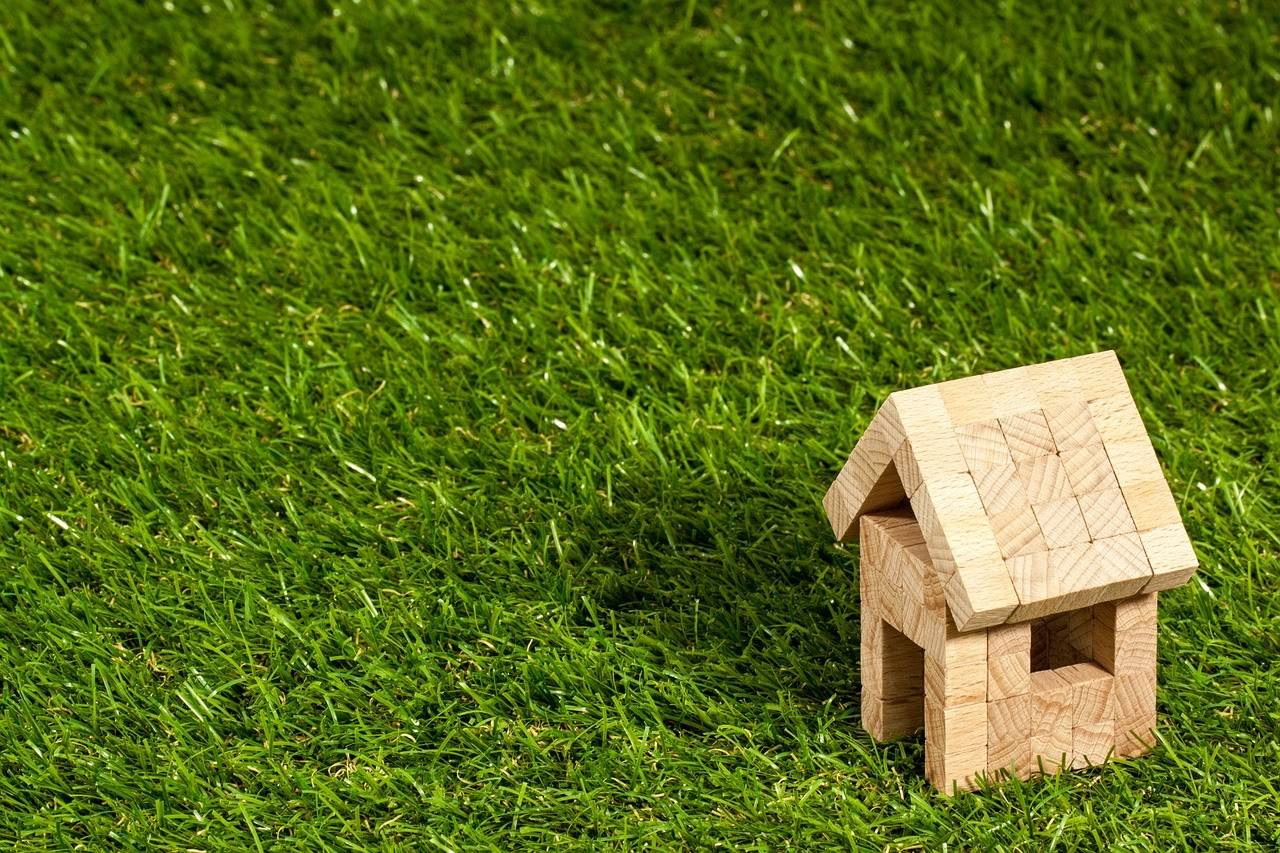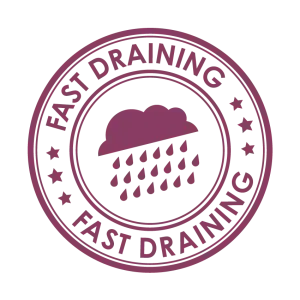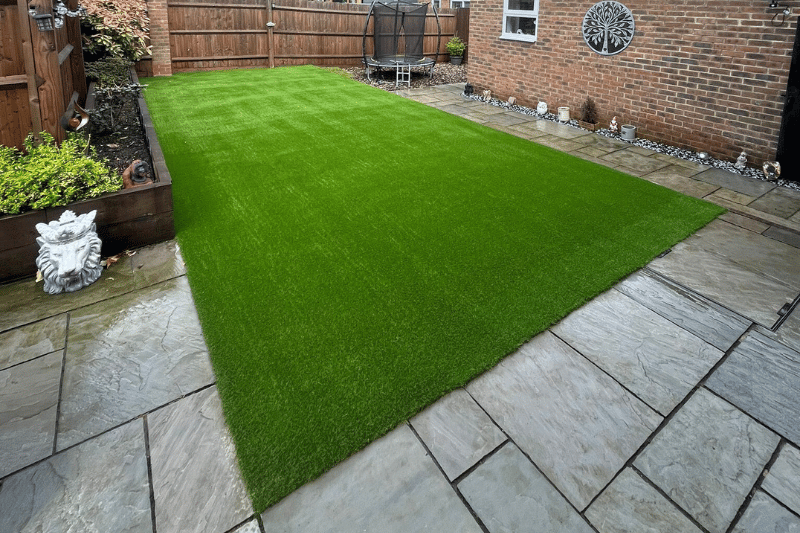The Grass is Always Greener with a Prestige Lawn: The Ultimate Guide to Artificial Grass

Struggling to make the decision to move over to artificial grass? This blog has got it covered.

The old saying goes that “the grass is always greener on the other side”, and though this may mean that one should be wary of how better things may seem in someone else’s life, other’s can choose to take this idiom a little more literally.
- What is Fake Turf/Artificial Grass?
- What is the Difference Between Turf and Artificial Grass?
- Pros & Cons: Comparing Artificial Grass and Natural Grass
- When to Lay Turf/Artificial Grass
- Uses for Artificial Grass
- How to Level Soil Before Laying Artificial Grass
- How Often Should I Water Artificial Grass?
- When to Mow Turf
This is especially true for those concerned with the condition of their lawns.
Tending to a garden can take up a considerable amount of free time; keeping each blade of grass prim & proper as well as, well, alive. Money and resources are also susceptible of being sacrificed in the name of having a greener garden, yet this isn’t the only option for having the most luscious lawn on the block. Enter artificial grass.
Some may be surprised to find that those delightfully green lawns are actually made up of artificial grass; the modern invention that makes lawncare a breeze. Some may also be a little hesitant when thinking about the synthetic alternative to natural grass.
Labelling artificial grass as ‘fake grass’, for example, is a somewhat tasteless version of describing it, as this could misconstrue just how real synthetic grass can look and feel. This is why here at Prestige Lawns we’ve set out to answer any lingering questions as well as dispel any myths or misconceived notions about artificial grass with this; the ultimate guide to artificial grass.
What is Fake Turf/Artificial Grass?
Artificial grass, otherwise known as fake turf, Astro turf or synthetic grass, is a surface made from synthetic fibres that look and feel like natural grass, depending on the quality and type. Primarily used as a replacement for natural grass outdoors, artificial grass can also be easily installed indoors as it requires none of the maintenance needed for natural grass.
First developed in 1966s, going under the name ‘Chem Grass’ before being colloquially known and eventually rebranded as ‘Astro Turf’, artificial grass has gone through several noteworthy changes in design, often being referred to as ‘generations’, with three generations being clearly distinct from one another. Today, most artificial grass manufacturers and suppliers design, create and offer some variant or iteration of third generation artificial grass, with some types boasting quality to rival even natural grass.
What is the Difference Between Turf and Artificial Grass?
Turf: In a move that some would label as baffling, companies often use the word ‘turf’ to refer to both rolls of natural grass as well as what’s known as ‘Astro turf’. If a company specialises in artificial grass it will use the term ‘turf’ to refer to this lesser quality artificial grass, yet conventionally turf is the name given to rolls of natural grass.
Astro turf/First Generation: Turf is first generation artificial grass, and is of considerably lesser quality. Often dubbed ‘Astro turf’ (a word that’s even in the English Dictionary), first generation artificial grass became best known as the surface in which the major league baseball team, the 1966 Houston Astros.
Artificial Grass/Third Generation: Artificial grass is the name that’s usually given to third generation artificial grass and is considerably more realistic than its predecessors. Given the advancements in the industry, there are a variety of different iterations of this generation of artificial grass, varying in length, shading and even how absorbent it is.
Second Generation: For the record, second generation artificial grass was created in the 70’s and known as ‘shaggy turf’. It improved upon the rough nature of Astro turf yet wasn’t considered a viable option for the likes of football, so is largely considered to be an impractical product to produce nowadays.
Call Now: 01908 542422
Pros & Cons: Comparing Artificial Grass and Natural Grass
Artificial Grass:
PROS:
- Lower Cost: Artificial grass requires just one upfront payment; after that it’s got a lifespan of anything from 15 years to 20 years. As far as investments go, artificial grass’ one time payment is considerably more cost effective than consistently paying for natural grass, what with the need to buy a lawnmower, fertiliser, and even the grass itself if it’s purchased in a rolled up formal.
- Minimal Maintenance: This plus point is especially noteworthy when compared to its natural counterpart. While natural grass can take hours each week to maintain, keeping it trimmed to a desired length and ensuring it remains green (i.e. alive) artificial grass only needs the occasional brushing with the odd splash of water whenever the occasion calls for it, such as in the case of cleaning up after a pet.
- Water Conservation: Speaking of cleaning up, artificial grass never requires any watering; serving as a stark contrast to natural grass. Whereas natural grass needs regular watering (especially if you live in a particularly dry or arid environment) artificial grass never needs a drop of water to keep looking lush & green, unless it’s being thoroughly cleaned.
- Environmentally Beneficial: Yet another point in artificial grass’ favour is that it helps the environment, as it requires absolutely no fertiliser or pesticide. The lack of these materials being used means that your lawn won’t harm the environment, or any animals living in it.
CONS:
- Hot Environment: Of course, nothing is perfect, yet one of the only problems with artificial grass is its heat retaining nature. Being made of plastic, artificial grass is much more susceptible to gaining heat than natural grass, which means it can be uncomfortably hot to the touch in hotter climates. This can be an issue if you have kids that play on the lawn or you like to walk around barefooted.
- Static Potential: Although most types of artificial grass is designed to feature anti-static behaviour it is still made of plastic, a material that can gather static. Though it’s a small possibility the risk of a mild static shock does exist.
Natural Grass:
PROS:
- Safe Recreation Surface: Unlike artificial grass, natural grass is, more often than not, a cool surface. It is also naturally cushioned. This cushioned benefit can be emulated to a degree in artificial grass by installing a shock pad underneath, though it’ll hard to make it as soft to the touch and shock absorbing as natural grass.
- Natural Cooling Agent: Natural grass naturally cools itself, having evolved to deal with fluctuating temperatures. Natural grass offsets roughly half of the solar heat it’s exposed to via cooling evaporation; an effect that can be so effective that it can save money on air conditioning in rooms close to the lawn.
- Improved Air Quality: Although some specially design artificial grass can contain antibacterial properties, it does conventionally fill the air with dirt and dust much more readily than natural grass.
CONS:
- High Maintenance Required: Arguably the greatest weakness of natural grass when compared to artificial grass is the upkeep required to keep the grass fresh, green and, of course, alive. Mowing the lawn, fertilising it and generally tending to natural grass is a hassle that can take hours of dedicated time.
- High Cost Factor: As well as costing a lot of time, natural grass can cost a lot of money to maintain. The only other alternative to maintaining natural grass with expensive equipment and materials is to hire a professional to tend to it. Though this may save time it’ll certainly cost money.
- High Water Usage: Finally, on an environmental note, it’s reported that the average lawn requires thousands of litres of water a year to keep it in proper order; a staggering number that’s all the higher when in areas that are susceptible to droughts. It goes without saying that this abundance of water could be saved should a lawn convert to using artificial grass.
Is artificial grass recyclable?
Surprisingly, the answer is yes. Some may believe that, because it’s made of plastic, artificial grass is bad for the environment, yet as most modern types of artificial grass is recyclable it’s already better for the environment. That’s before even taking into account how installing artificial grass in a lawn removes the need to use materials that are harmful to the environment, such as fertiliser and pesticide.
How to Lay Artificial Grass in a Garden:
When it comes to laying artificial grass or fake turf in the garden (or anywhere else you’d want to install it) it really is best to leave things in the hands of a professional, though if you fancy yourself to be quite capable with DIY you’ll need to fulfill a few criteria first as well as obtain some specific tools.
Of course, the preparation required will depend on your pre-existing circumstances; namely what kind of surface you wish to turf. There are three main types of surfaces that artificial grass is typically installed on; soil or sand, decking and concrete.
Soil or Sand:
It should noted that, though it is technically possible to install turf in this manner, we do not recommend doing so. For those without an alternative, the method can be seen below.
First, you need to ensure that the surface is even and that any prior vegetation is removed; this includes weeds and even grass. For small areas, evening the surface can be easily achieved by using the back of a spade or a builder’s plank, however larger areas should probably be tackled by using specialist equipment, such as a vibrating plate compactor. Of course, you could manually level a surface of soil or sand with the likes of the back of a shovel, though the process would probably take a considerable amount of time.
The even surface you’re left with should be, at a minimum, a 35mm layer of compressed soil or compacted sharp sand, on top of which a weed membrane should be applied. This will prevent the likes of seeds finding their way down into the natural ground and germinating. Once this membrane has been installed you can place the artificial grass on top of it, and to ensure there are no creases or wrinkles it’s best to leave the turf to settle for around 24 hours.
Once you’re happy that the artificial grass has settled it’s time to join it all together. Butt any edges together and, once satisfied everything lines up, apply some fibreglass backing tape underneath the joins. Next apply some moisture-curing adhesive or mulit-purpose adhesive to the backing tape using a spreader to ensure an even application and fold back the grass. Take care not to accidentally get any of this adhesive to the grass itself.
Once the fake turf has been successfully adhered you can cut and trim it to make it fit to whatever shape you want it it to be, as well as removing any loose sections. Be sure to use an appropriately sharp knife and change it whenever it becomes too dull. Once satisfied with how everything looks, fix the artificial grass down with ground pins, leaving a 200mm distance between each pin around the perimetre.
Decking:
Installing artificial grass on decking is considerably easier than on soil or sand, as usually the weight of the artificial turf itself will be enough to keep it on the surface. Any strong winds can be countered by placing the likes of big potted plants or garden furniture on top of it. However, steps such as trimming the artificial grass to the desired size will still be needed; this will require a sharp knife.
Certain steps can also be taken to enrich the feel of your artificial grass. To grant it a more absorbent feel, lay an exterior underfelt below the turf, adhering it to the decking and to the artificial grass using moisture- curing or multi-purpose adhesive.
An even more simple, albeit slightly more ‘permanent’ means of installing artificial grass to decking is simply by stapling it down with a staple gun or screwing in a few screws.
Concrete:
As is the case with any other means of installing artificial grass, ensure that the surface is clean and smooth. In the case of slight imperfections upon the concrete, making use of a self-levelling compound can help smooth things out; a necessary action if your chosen artificial turf is more on the thin side.
Given the resilient and firm nature of concrete it’s greatly advised that you install an underfelt layer beneath the artificial grass. This can be achieved in the same manner outlined in the decking section above. The distinction between applying fake turf on decking and concrete is that this step is more or less a necessity.
Once installed, simply join and trim the artificial grass, much in the same manner as outlined above.
When to Lay Turf/Artificial Grass
- Laying and installing artificial grass can be done at any time of the year, given its artificial nature. This is one of the many advantages to utilising artificial grass, as it needs little to no maintenance, though if you do wish to lay turf rolls you’ll have to plan things with greater consideration.It’s generally advised to lay natural turf when the surrounding soil (or, more namely, the soil it’s being laid onto) is dry and mildly warm. Because of this it’s best to lay turf rolls during early spring or mid-autumn, as throughout winter the ground will be too frosty and throughout summer the turf will require watering considerably more frequently.
Leaving turf undisturbed for a few weeks ensures that it will look fresher and live longer, so consistently watering it to keep it alive will disturb the process of the turf assimilating with your lawn.
Uses for Artificial Grass
As previously discussed, there are plenty of practical applications for artificial grass outside of being placed, well, outside. Being synthetic grass, artificial grass can be installed inside for purposes ranging from aesthetic style to practical applications, some of which include:
- Sports: Whether it’s installed outdoors or in an indoors, installing artificial grass on any sport pitch is a widely utilised practice, so much so that different kinds of shoes and boots are advised for different generations of artificial grass.
- Play areas: Schools, parks and even nurseries commonly make use of artificial grass, not just because it’s easier to maintain and clean but because it can easily be installed and often serve as a safer alternative. Something charming to remember in the case of nurseries is that artificial grass can be actually be manufactured in different colours, making them an extra element to play times.
- Commercial installations: One of the more potentially creative uses for artificial grass is for business, the likes of which can be used to transform bland interiors into wonderful fun spots, such as mini-golf courses or even indoor themed attractions like mock safaris.
- Home gardens: Finally, the most environmentally sound and practical application of artificial grass is as a substitute for natural grass in gardens.
How to Level Soil Before Laying Artificial Grass
- As aforementioned, small areas using the back of a shovel should be an adequate enough tool for smoothing out soil. Larger areas will require more specialised equipment, however, which should be operated by professionals, such as a vibrating plate compactor.
How to lay artificial grass on existing grass
- Many experts and professionals would argue that it isn’t possible, nor would it be practical, to lay artificial grass directly upon existing, natural grass. The reasons behind this can largely be attributed to two main points.First, any natural grass underneath the artificial grass would die and rot, needing to be removed eventually, and secondly, having a lawn with a mix of artificial grass and natural grass would require two starkly different methods of maintenance; cancelling out the benefits of either types of grass.
How thick is fake turf/artificial grass
- Depending on brands and variants, artificial grass can vary in thickness though is usually anywhere between 20mm and 40mm. Cheap artificial grass will be thinner, much less absorbent and less realistic.
When can you walk on fake turf/artificial grass?
- As soon as artificial grass is installed you can walk upon it, though as it is made of plastic it has heat retaining properties and may become rather hot to the touch. Having artificial grass installed in sunny and warm countries and states, such as Italy and the lower states of North America, may result in a newly turfed garden being uncomfortably warm under bare feet, so remember to keep this in mind.In regards to running on fake turf/artificial grass, the type of artificial grass determines which kind of shoes are best for your feet. First generation artificial grass, or traditional turf, requires boots with turf soleplates, whereas third generation artificial grass requires boots with FG (or, ‘firm ground’) soleplates.
How Often Should I Water Artificial Grass?
- Given that artificial grass is made from synthetic fibres it doesn’t need to be watered in the same way that natural grass does. Watering artificial grass is merely required for cleaning purposes, and as such should only be done when the need arises.Most of the cleaning requirements for artificial grass can be accomplished by simply sweeping or brushing, with watering only required for spills, stains or residue left behind by a pet or an animal.
When to Mow Turf/Artificial Grass
- Unless the turf is natural grass it need never be mowed as it will never grow. After all, this is one of the primary benefits of having artificial grass.If the turf did arrive as rolled up natural grass then it will require no addition or special maintenance when compared to conventional grass. Depending on what type of natural grass you have the growth rates will differ, though most agree that a weekly mowing session should suffice. It’s all in the eye of the beholder to decide what length is ‘too long’ after all.
Want to know Have any other questions or queries? Take a look at our FAQs. Curious about seeing and feeling how real artificial grass can be? Get in touch about some free samples. Curious about how you can make other homeowners on the other side of the fence jealous? Contact us about discovering how Prestige Lawns can make your lawn fantastic. And of course, feel free to get in touch with us via [email protected] or giving us a call on 01908542422!
Homes & Gardens Case Studies


Artificial Grass Fit for Football Royalty

Garden Makeover in Aylesbury with Classic Artificial Grass

Year-Round Usability with Classic Fake Grass in Newport Pagnell

Effortless Greenery with Solis 38mm Artificial Grass in Leighton Buzzard

CHILD SAFE
Say goodbye to scraped knees and muddy footprints! Our artificial grass is the perfect playmate for your little ones, providing a safe and soft surface for all their adventures, without sacrificing on the fun factor!

PET FRIENDLY
Let your furry friends roam free without the worry of muddy paws or patchy spots! Our dog friendly artificial grass is paw-some for pets and their owners alike, providing a soft and durable surface that can withstand even the most rambunctious of playtimes.

ECO FRIENDLY
By switching to artificial turf, you’ll be helping to conserve water, reduce carbon emissions, and eliminate the need for harmful pesticides and fertilizers. So, let’s save the planet and get your lawn looking lush and green!

FAST DRAINING
Our artificial grass is so fast-draining, you’ll never have to worry about being stuck in a swampy situation again. Let’s keep your yard looking great, rain or shine!

UV STABILISED
Did you know that our artificial grass is UV stabilised? That means it can handle your endless summer days without losing its colour or getting damaged by the sun’s rays. So go ahead, soak up that vitamin D and enjoy your green, lush lawn all year round!




